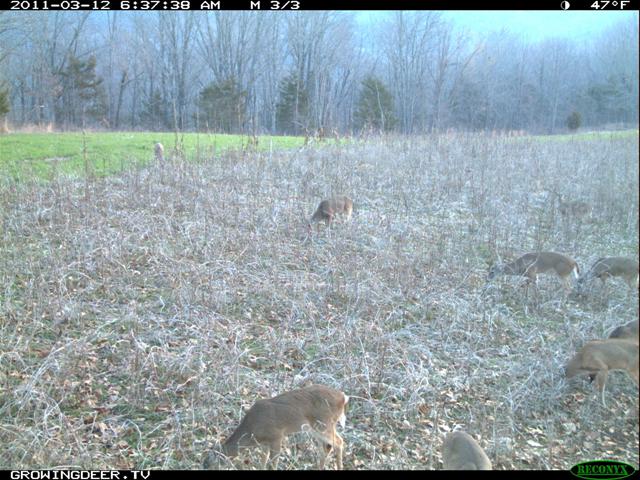Category: Food Plots
Creating Hidey Holes
Brad, Hunter, Nathan, and I scouted some areas for new Hidey Hole food plots today. Hidey Hole plots are small plots that are usually less than an 1/8th of an acre in size. I usually create them by using hand tools – no tractors or mechanical equipment. The ideal location for a Hidey Hole plot is an area where:
- Deer frequent
- Hunters can access without being detected by deer
- Wind direction usually remains constant (like a ridge top)
- It helps if no large trees need to be removed
We like to locate these areas this time of year to limit disturbance to the deer herd closer to season. In addition, we begin killing brush, etc., now with a herbicide so when we remove saplings they don’t sprout back. We kill any grass or broadleaf weeds with a herbicide so they will dry up before planting season.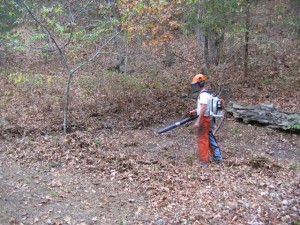
Just before planting the forage crop, I add ample fertilizer to help the forage crop grow rapidly and taste palatable to deer. For example, one 50 pound bag of 19 19 19 fertilizer applied to 1/8th acre is equivalent to applying 76 pounds of N, P, and K (400 pounds of 19 19 19) per acre. That’s usually enough to get a forage crop like wheat up and tasty for a month or two of great forage production. I plant the crop roughly three weeks before I anticipate hunting or the first frost. I also hang my Muddy stands and secure my Muddy SafeLine well before hunting season.
I try to avoid the area from when I plant until I hunt to allow deer to become conditioned to feeding in the area without being alert to two-legged predators. This is a critical step in creating a successful Hidey Hole food plot. In addition, I only hunt this location when the wind direction is appropriate. I don’t waste the effort spent creating the hotspot by allowing the local deer to associate the spot with human (predator) activity.
This is a great technique to see and harvest mature bucks that can be used on properties from ten to 1,000 acres. Hidey Hole food plots are not designed to increase the quantity of nutritious forage in an area, but to allow hunters to observe and harvest mature bucks at close range by providing high quality forage with minimal equipment and expense. Hidey Holes are a great tool to harvest mature bucks.
Growing Deer together,
Grant
Using Maps To Plan Where to Hunt this Fall
There has been much written about using maps to locate stand locations. I use topo maps, aerial images, etc., to learn the lay of the land, especially when hunting a new area. However, I study the NOAA Drought Indicator maps to plan which state or region to go hunting and to assist me with planning food plot strategies for both fall and spring.

NOAA’s drought indicator maps are available online and for free. They are maps that predict the amount of precipitation or lack thereof for the lower 48 states. It’s obvious why predictions of precipitation amounts are important for planting crops. It may not be obvious why I use them to plan where to hunt.
I’m not using them to plan where to hunt based on the chance of getting rained out! Those predictions are rarely accurate. Meteorologists rarely can predict precipitation three days out let alone three months out with accuracy. However, they are much better at studying ocean temperatures, currents, etc., and predicting general amounts of precipitation a region will receive. Precipitation is a key determinant of antler production.
You may recall that I frequently state in blogs and in episodes that plants are simply nutrient transfer agents. They can’t transfer nutrients to deer if the nutrients aren’t in the soil. If not enough precipitation occurs, the plants can’t use the available nutrients. Most folks associate drought conditions with poor forage quality. In fact, in south Texas there is great research that shows a very strong correlation between rain during the early spring and the average size of antlers per age class that year.
What hunters may not consider is that too much rain can be just as detrimental to antler growth as drought conditions. This is because too much rain can leach the nutrients in the soil deeper than the forage roots’ reach. When too much rain occurs in production ag fields, the farmers usually have to reapply fertilizer to make a productive crop. Still, the crop usually isn’t as productive (bushels per acre) or nutritious as the plants were not adequately fed during the period of above normal precipitation.
This year there are several areas that have received substantially more or less precipitation than normal. In both cases, there’s a good chance the native and cultivated forage there won’t be as nutritious as normal and as a result antler development will likely be less than average.
On the NOAA Drought prediction maps, I like to hunt areas that are white or light green (slightly above average precipitation) during the early spring through summer so antler production will likely be normal or above average for the area. The Proving Grounds has received a bit much rain so far this year, and that trend will likely continue based on NOAA’s predictions. Antler development may be hindered if predictions are accurate and especially if conditions are worse than predicted.
Based on this, how’s antler development looking for your area?
Growing Deer together,
Grant
Good Genetics!
I often hear folks say “The deer have good genetics there!” They almost always say that because the deer “there” have bigger antlers, heavier body weights, etc. However, almost always the “there” is where crops such as corn or soybeans are produced. To know genetics requires knowledge of the pedigree (who bred who for several generations). That information is almost never available for critters from a free-ranging herd.
However, data that is easily obtainable is what deer and turkey are consuming. This is accomplished by simply checking the stomach or crop content of recently killed critters. Turkeys at The Proving Grounds have had body weights above average for the local area for several seasons. These elevated body weights were noticed after I began planting Eagle Seed forage soybeans and corn in the food plots. This spring, I’ve examined the crop content of every turkey we’ve harvested (five) to date. Each one included the seeds from the Eagle Seed forage beans. In fact, four of the five harvested only had soybean seed in their crops.
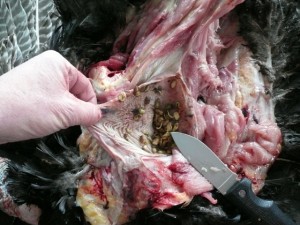 I remember an esteemed scientist stating at a conference many years ago “the best way to improve genetics is nutrition, nutrition, nutrition.” I would redefine that a bit and say there is no way to improve genetics of free-ranging wildlife. However, by significantly increasing the amount of high quality forage and grain available for consumption you can improve the body and antler size and the number of fawns recruited for free-ranging wildlife.
I remember an esteemed scientist stating at a conference many years ago “the best way to improve genetics is nutrition, nutrition, nutrition.” I would redefine that a bit and say there is no way to improve genetics of free-ranging wildlife. However, by significantly increasing the amount of high quality forage and grain available for consumption you can improve the body and antler size and the number of fawns recruited for free-ranging wildlife.
The Proving Grounds is in an area dominated by high-graded timber and fescue pasture. There are no production corn or soybean crops nearby. However, the wildlife we produce and harvest have similar body weights and antler size as critters in ag production areas. We’ve taken no steps to alter the genetics of our herds and flocks. We have grown quality grain and forage for their consumption. My neighbors probably think “the deer at The Proving Grounds have good genetics.” The local deer herd shares the same genetics. However, the deer at The Proving Grounds can express their genetic potential because of the quality forage and grain crops. Brad and I just returned from working on our no-till drill. To some, we were working on improving the genetics of the local deer and turkey populations.
Growing Deer together,
Grant
Bag Maps…
It’s snowing and cold in Western Kansas today. In fact, they’ve shut down I-70 throughout most of western Kansas. It is turkey season in that region, but if you plan to hunt there take your warm deer hunting clothes! If you’ve already planted food plots in that area, pray for a rapid warming trend!
It’s cool and very windy at The Proving Grounds today also (no snow thankfully). Although all of my food plots have been sprayed and fertilized, I haven’t planted any crops yet this spring. It’s a good thing as seed that is moist and cold can rot or germinate and then die easily.
This is why I dislike the maps on seed bags that show customers when to plant based on where they live. These data are based on averages over a number of years, and are usually accurate when comparing one region to another. However, they are rarely accurate when considering exactly when to plant at a given location. This is because soil temperature and soil moisture levels usually vary significantly at the same location from year to year.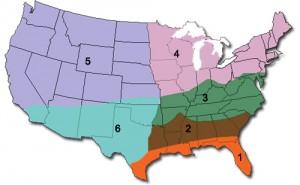
I like to plant each crop as early as practical during the spring. The chances of drought stress (which is caused by a combination of air temperatures and lack of soil moisture) are greater as the temperatures increase. However, each farmer should monitor the local conditions and the weather forecast before deciding when to plant.
Hunters should know this lesson well as they often attempt to use long-term forecasts to plan vacation days to hunt. Then as the date for them to hunt nears, the weather changes and it is 85 degrees and very few deer are moving during daylight hours. The same is true for when to plant food plots. I use the past data (like bag maps) as a guide for when to have the seed and equipment ready to plant. However, I wait until the local conditions are correct before placing valuable seed in the ground. Bag maps are good for general planning, but for site-specific data, they aren’t worth much more than the paper they are printed on.
Growing Deer together,
Grant
Year Round Food Plots: The Magic Bean!
I was part of a panel at a national convention years ago when a member of the audience asked each member of the panel what they thought was the “magic bean” for food plots. Each member of the panel except me offered a suggestion like clover, brassicas, peas, etc. I refused to answer. I agreed with my colleagues that each of the crops they mentioned had good characteristics, but each also had obvious limitations.
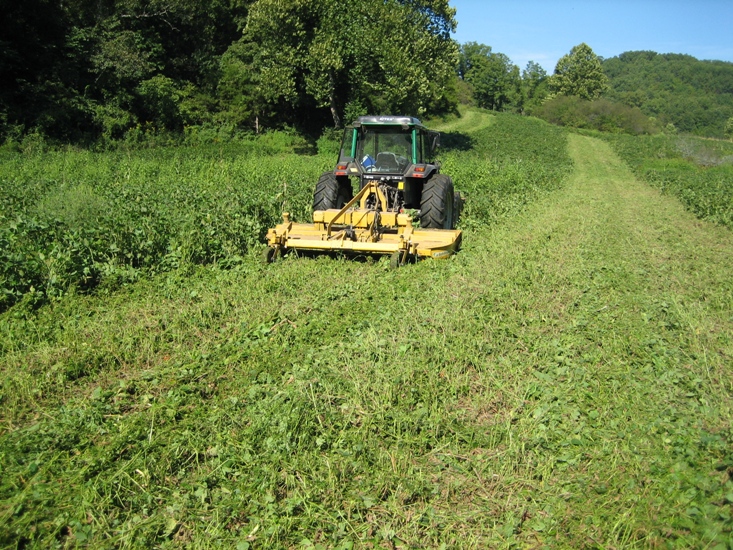 In the decade or so that has passed since that conference I’ve designed, established, maintained and/or evaluated literally 1,000’s of acres of food plots planted in dozens of different crops. Some of those crops proved to be totally unused by deer or the preferred species of game (hence a weed for the food plot mission) or their ability to produce substantial high quality forage was limited, or limited to a very small geographic area.
In the decade or so that has passed since that conference I’ve designed, established, maintained and/or evaluated literally 1,000’s of acres of food plots planted in dozens of different crops. Some of those crops proved to be totally unused by deer or the preferred species of game (hence a weed for the food plot mission) or their ability to produce substantial high quality forage was limited, or limited to a very small geographic area.
During that time I was introduced to forage soybeans. The first plot of forage soybeans I planted was in Mississippi. I remember being amazed at the tonnage of forage. During late August the forage was mowed and I advised the landowner to plant a common winter crop such as wheat. During the next few years I planted or advised more folks to plant forage soybeans as the yield of high quality forage was better than any other crop during the growing season. Years later, I noted that the Eagle Seed forage soybeans were producing a tremendous amount of pods!
A good stand of winter wheat will yield 1,200 to 1,600 pounds of forage per acre. One very poor crop of Eagle Seed forage soybeans (30 bushels per acre) yields 1,800 pounds of high quality grain (soybeans) per acre. I realized that when I mowed the Eagle Seed soybean forage during the early fall, I was mowing down more high quality winter food than what the next crop would likely produce! The beans were already available while I or my clients had to pay for the labor, seed, and fertilizer to gamble to produce another crop.
I’ve now practiced for years a strategy of establishing a high quality crop of forage soybeans and allowing deer and turkey to forage on the vegetation throughout the growing season. Then I leave the crop standing and allow the same critters to consume the seed pods throughout the winter. The crop literally can provide high quality food until it is time to prepare for planting another crop the following spring.
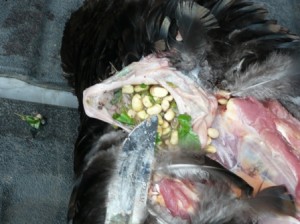
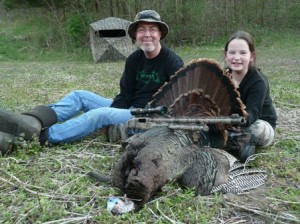 Forage soybeans can produce high quality food for 11 months, from one planting and one expense. I was reminded of the huge advantages of forage soybeans while I was cleaning a gobbler my oldest daughter, Raleigh (age 12), harvested this past weekend. After removing the gobbler’s breast, I opened the crop to see what he had been eating. We call this scouting from the skinning shed. By seeing what critters are currently eating, a hunter can accurately predict where other members of the same species will be consuming the next few days. Raleigh’s turkey was full of soybean seeds! Using this M.R.I. (Most Recent Information), I took my youngest daughter, Rae (age 9) hunting that afternoon. We selected a location overlooking a forage soybean field that had been planted the previous spring. She harvested a mature gobbler there that afternoon.
Forage soybeans can produce high quality food for 11 months, from one planting and one expense. I was reminded of the huge advantages of forage soybeans while I was cleaning a gobbler my oldest daughter, Raleigh (age 12), harvested this past weekend. After removing the gobbler’s breast, I opened the crop to see what he had been eating. We call this scouting from the skinning shed. By seeing what critters are currently eating, a hunter can accurately predict where other members of the same species will be consuming the next few days. Raleigh’s turkey was full of soybean seeds! Using this M.R.I. (Most Recent Information), I took my youngest daughter, Rae (age 9) hunting that afternoon. We selected a location overlooking a forage soybean field that had been planted the previous spring. She harvested a mature gobbler there that afternoon.
By using the technique of scouting from the skinning shed, I was able to confirm that Eagle Seed forage soybeans provide high quality food (forage with high quality protein during the summer and seeds with high quality energy during the winter) at least 11 months throughout the year.
If I was asked the same question at a conference again today, I would have a much better idea of what the “magic bean” is for wildlife food plots. It is a forage soybean that also produces gads of grain.
Growing Deer together,
Grant
Big Bucks are Usually Seen Where the Combines Roam
I was in Kansas turkey hunting last week and visited with a friend there that asked about maximizing the potential of his deer herd. He is a very talented deer manager and an incredible hunter. His stalking skills are by far the best I’ve ever witnessed. He makes me sound like an elephant going through the woods. He lives in an area where combines roam the country side every fall. After getting to know his property, I felt there was one component missing from his deer management practices: standing grain during the winter.
Standing grain provides a great source of digestible carbohydrates to deer and other wildlife. Carbohydrates equate to energy and energy is often the most limited factor in a deer’s diet. Most folks only consider protein when producing crops/habitat management for deer. This is a mistake if the goal is to allow deer to express most of their genetic potential.
Most whitetail hunters realize that most record book bucks are harvested in the agricultural regions of the Midwest. However, they may not realize one of the primary reasons why this trend occurs is because of the quality soils and the excess of grain produced and left available through the winter as combines are not 100% efficient.
The Proving Grounds is located in the very southern portion of Missouri – about 20 miles from the Arkansas border. The world class deer harvested in northern Missouri are direct ancestors from the “dog-sized deer” in southern Missouri, as Missouri primarily restocked deer into the northern (grain producing) counties from the Ozark Mountains of southern Missouri. Many folks wrongly assume there is a genetic difference between the deer north of the Missouri River and the smaller deer in the Ozark Mountains of southern Missouri. The difference is that I’ve never seen a combine in the two counties that split The Proving Grounds.
By producing good quality forage crops during the summer (protein) and grain crops (corn and soybeans) left standing during winter, I’m able to produce northern Missouri quality deer in counties where there has never been a Pope and Young or Boone and Crocket buck recorded (Stone and Taney Counties, Missouri).
The take home message is that folks almost anywhere can allow deer in their neighborhood to express more of their antler growth potential. One of the keys is to provide a good source of energy (grain) through the winter months. Standing soybeans and corn are the least expensive and healthiest method to provide grain to the local wildlife population if you don’t live where combines are a common sight. Even if you live where combines roam, you may be an island where there is no grain, and the local herd may not express much more potential than their distant relatives that don’t ever see a combine.
Growing Deer together,
Grant
If It’s Not In The Dirt, It Can’t Get To The Antler
Large antlers are simply a bi-product of healthy, mature bucks. The availability of nutrients in the dirt determines how healthy, drought resistant, productive, etc., plants can be. If the right quantity of nutrients isn’t in the dirt, they can’t feed the plants, and the plants therefore can’t transfer these nutrients to deer. Simply put, if deer don’t consume food produced from good dirt, they can’t produce antlers to their fullest potential.
Given this very simple, but important fact, I’m amazed that every serious deer manager doesn’t collect soil samples and have the soil in their food plots analyzed. The price of having a soil sample analyzed is about $15 per sample. That’s one of the least expensive and most important tools I use as a deer manager.
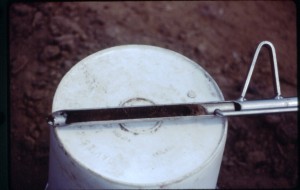 The results of a soil sample include the soil’s pH, and the amount of phosphorous, potassium, and several other trace minerals (depending on the analysis requested). This information is then used to determine how much lime and fertilizer is needed to produce a quality crop.
The results of a soil sample include the soil’s pH, and the amount of phosphorous, potassium, and several other trace minerals (depending on the analysis requested). This information is then used to determine how much lime and fertilizer is needed to produce a quality crop.
However, the information is even more valuable than a generic recommendation! The results will state how much of each element is necessary based on the crop and desired yield you wish to grow!! For example corn requires much more nitrogen than soybeans or clover. To get the best yield and therefore give the deer a better opportunity to express their full antler development potential, it’s critical to apply the appropriate quantity and quality of each element required for each crop. This is exactly where many food plot farmers miss the boat. They collect soil samples and send them to a lab to be analyzed. However, without telling the lab the exact crop or blend of crops to be grown in that plot, the lab is forced to either not provide any recommendations or provide a generic recommendation. This usually results in producing crops that don’t express their full quality or quantity potential, and therefore the deer that consume these crops can’t express their full potential.
I just received the soil test results from Waters Agricultural Laboratories for every food plot at The Proving Grounds, complete with a unique lime and fertilizer recommendation for each crop. Soil tests are a fabulous tool to tune up a deer herd. If it’s not in the dirt, it can’t get to the antler.
Growing Deer together,
Grant
Crunch Time!
Depending on the latitude and winter conditions where you manage deer, late February and March are usually crunch time for deer. Quality native food resources are usually depleted and new growth hasn’t started yet. If your management goal is to allow deer to express their full genetic potential, it is critical to ensure deer (and other critters) have access to quality forage and grain.
Standing corn is a great crop this time of year!! The ear of many modern varieties of corn tips down when it’s ripe. 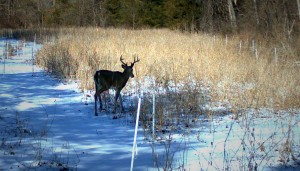 The husk then sheds moisture from the grain and prevents mold from developing. There’s not many less expensive ways to provide energy-rich corn for deer than growing it and leaving it standing. The same is true for Eagle Seed forage soybeans. The actual grain is protected from moisture by a pod.
The husk then sheds moisture from the grain and prevents mold from developing. There’s not many less expensive ways to provide energy-rich corn for deer than growing it and leaving it standing. The same is true for Eagle Seed forage soybeans. The actual grain is protected from moisture by a pod.
Throughout most of the whitetails’ range there is no forage growing during late winter. Standing corn and soybeans provide high quality food during a critical stress period! One reason why deer in the Midwest express more of their antler growth potential than in most areas is the availability of spilled grain in the production corn and bean fields. Although not much grain is left standing, a small percent of spilled grain adds up given the vast acreage of harvested grain.
Would you like to have Midwest quality deer at your hunting area? Then make sure the deer at your hunting area have access to standing corn or soybeans during crunch time!
Growing Deer together,
Grant
Pruning Fruit Trees
Hi Grant, I have been following your website for the past several months and truly enjoy receiving my latest edition from you each Monday. I am planting a dozen or so fruit trees. I know nothing about fruit trees other than I want to provide even more food for the deer and turkeys. The trees I have are about 6-7′ tall and are in 3 gallons. I am assuming they are probably 2-3 years old. Do you have any suggestions on pruning fruit trees? Thank you for what you are doing and may God continue to bless you richly. Kindest, Jason
Jason,
Thank you for the kind words and for watching GrowingDeer.tv! Different species of fruit trees require different pruning strategies. In general, most folks don’t seem to prune enough. However, I suggest you visit with the supplier where you purchased the fruit trees, or checkout some articles in Quality Whitetails or on the Quality Deer Management Association web site. They have published several articles that are specific to different species of fruit trees. Specifically I would recommend reading “A User’s Guide to Successful Apple Tree Plots.”
Growing Deer together,
Grant
Sunshine and Spring Weather (Finally)!
It is amazing how much difference a day can make. This past weekend we had ice and snow. Today it is in the sixties and sunny. Wheat and clover plots are popping and I’m sure the turkeys like it. I’m on my way to work in Mississippi and Alabama where I can enjoy being outside and working in some warm weather. The soil sample results should be back today. As soon as the ground dries out it will be time to spread Antler Dirt and prepare for spring food plots.
Growing Deer together,
Grant



